This set of Mechanical Metallurgy Multiple Choice Questions & Answers (MCQs) focuses on “Metals – Torque and Power”.
1. The neutral point in the rolling machine is defined as the point where ________
a) the material enters the machine
b) the material exits the machine
c) the roll speed is equal to the material flow speed
d) the friction between the roll and the material is zero
View Answer
Explanation: The velocity of rolled material keeps on changing from entrance to exit. At the beginning, the roll speed is lower than material rate, then a point comes where the pace of roll and sheet is equal, and this is called neutral point.
2. The specific roll pressure is defined as _______________ in the rolling machine.
a) total rolling load
b) total load separating force
c) rolling load/contact area
d) rolling load/roll diameter
View Answer
Explanation: The specific roll pressure is defined as the total rolling load divided by the total contact area between the rolling material and the circumference of the roll.
3. For a roll of radius R, the entering and exiting material thickness is h1 and h2 respectively. What will be the total arc of contact between roll and material?
Δh=h1-h2
a) R(Δh)
b) R(√Δh)
c) √(RΔh)
d) R(Δh)2
View Answer
Explanation: The total contact length is defined as the square root of multiplication of roll radius with the change in the height of the rolling material.
-> [R(h1-h2)]1/2
4. The distribution of the roll pressure along the contact length of the metal in the rolling material is given by which of the following graph?
a)
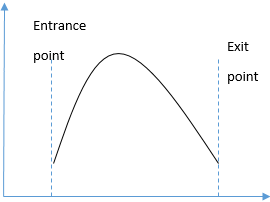
b)
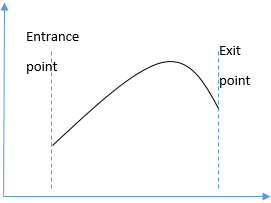
c)
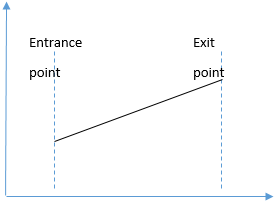
d)
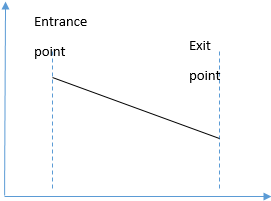
View Answer
Explanation: The roll pressure changes the position of the material in the roll, it is maximum in between the entering and exiting point but not necessary in the middle.
5. The roll pressure is always maximum at the neutral point and then falls off sharply.
a) True
b) False
View Answer
Explanation: The roll pressure varies along the length of the arc of contact. It will always be maximum at the neutral point.
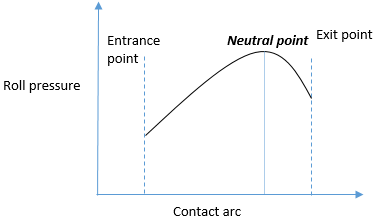
6. The neutral point always occurs in the mid-way of entering and exiting point of the metal along the arc of contact.
a) True
b) False
View Answer
Explanation: The neutral point is not necessarily to be in the middle of the arc of contact. If the backpressure is applied, the neutral point will shift forward and vice versa.
7. A roll of diameter 1.5 m is used to roll the sheet of width 100 mm. The stress on the machine is 50 MPa, and the change in thickness of the sample is 10 mm. Find the rolling pressure of the sheet?
a) 52.3 kN
b) 8258.5 kN
c) 612.3 kN
d) 5682.2 kN
View Answer
Explanation: The rolling pressure will be given by the following expression:
-> P=σ(area)
-> Area=width*contact arc
-> Contact arc=(R*Δh)1/2
-> Contact arc=1.5*10*10-3=(15*10-3)1/2 = 0.122
-> Area=100*10-3*0.122=0.0122 m2
-> P=50*106*0.0122=612.3 kN.
8. A roll of diameter 1.5 m is used to roll the sheet of width 100 mm. Find the stress on the machine, if the change in thickness of the sample is 10 mm. Given that the rolling pressure is 500 kN?
a) 50 MPa
b) 40.9 MPa
c) 568.2 kPa
d) 48.2 MPa
View Answer
Explanation: The stress will be given by the following expression:
-> P=σ(area)
-> σ=P/area
-> Area=width*contact arc
-> Contact arc=(R*Δh)1/2
-> Contact arc=1.5*10*10-3=(15*10-3)1/2 = 0.122
-> Area=100*10-3*0.122=0.0122 m2
-> Stress=500*103/0.0122= 40.9 MPa.
9. The mill spring in the rolling mill is defined as the phenomena of _____________
a) recoiling of the roll wheel
b) increase in thickness of rolled sheet after coming out of roll wheel
c) roll flattening
d) change in the gap distance between the rolls with time
View Answer
Explanation: Few very plastic material tends to regain their shape partially after the rolling, so this increase in the thickness of the metal after rolling is called mill spring effect.
10. There is no limit of the possible reduction in the thickness of the sheet metal, provided number of passes needs to increase.
a) True
b) False
View Answer
Explanation: There is a lower limit below which the possible reduction of the material cannot be possible. This is because after a certain thickness, the roll itself starts deforming before the deformation in sheet metal occurs, thereby limiting the deformation of sheet metal.
11. If the gap between the rolls is not perfectly flat, which of the following defect can arise from this demerit?
a) Alligatoring
b) Waviness in the sheet
c) Centre burst
d) Stretcher strain
View Answer
Explanation: The uneven flatness between the rolls can produce a thickness difference between the sheet along its width; this causes the waviness in the sheet.
Sanfoundry Global Education & Learning Series – Mechanical Metallurgy.
To practice all areas of Mechanical Metallurgy, here is complete set of 1000+ Multiple Choice Questions and Answers.
If you find a mistake in question / option / answer, kindly take a screenshot and email to [email protected]
- Apply for Metallurgical Engineering Internship
- Check Mechanical Metallurgy Books
- Practice Metallurgical Engineering MCQs
- Check Metallurgical Engineering Books
